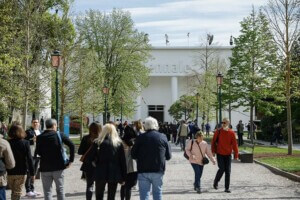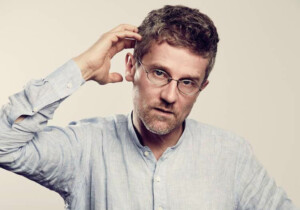This year’s architecture biennale in Venice is curated by the Ghanaian-Scottish architect and academic Leslie Lokko under the theme of Africa as a “Laboratory of the Future.” In this, the 18th edition of the event, Lokko introduces a diverse group of what she terms “agents of change:” architects, critics, and design professionals, among others, who run experimental practices in different parts of the globe. The emphasis, which comes as a breath of fresh air, is on the African context, but there are many projects that cross physical and ideological boundaries, that altogether make Leslie Lokko’s biennale so compelling.
Two architectural collectives among these “agents of change” were honored with the Biennale’s highest award, the Golden Lion. One went to Alessandro Petti and Sandi Hilal, cofounders of DAAR, for their work on the Fascist colonial town of Borgo Rizza in Sicily, which is on view in the Corderie. The other went to Gabriela de Matos and Paulo Tavares, who together conceived and developed the Brazilian pavilion’s Terra exhibition in the Biennale’s Giardini. DAAR’s pointed deconstruction of the Fascist architectural rhetoric, and the Brazilian pavilion’s deliberate peeling away of modernist narratives can be read as exemplary critiques of the postwar architectural canon.
Every edition of the biennale draws considerable controversy, and this time the polemics are about the diminished presence of starchitects. This time around, the elite cadre of architects are mostly huddled together in an off-Biennale venue. Their big event is the immense project called The Line produced by NEOM, on view at the Abbazia di San Gregorio. Visitors can inspect the massive 170-kilometer-long Saudi Arabian project that proclaims to be the stuff of “zero gravity urbanism.” So for the moment, at least, the critical momentum remains squarely on Lokko’s side.
The biennale continues through November 26, so there is still time to plan a visit to Venice and to draw your own conclusions. Presented below is the first of two exclusive interviews with the Golden Lion winners, a conversation with DAAR founders Alessandro Petti and Sandi Hilal. The interview was edited for length and clarity.

Peter Lang (PL): DAAR has been flying just under the radar for some years, earning praise but outside of the glaring lights that often come with star architecture status. What might change now that you have been honored with the Golden Lion, given that it’s one of the most prestigious awards inside the architectural profession? How might this affect your practice over the long-term?
Alessandro Petti (AP): Let’s start by saying that it has been heartwarming to see how this award was perceived by many as giving wider recognition for unorthodox and undisciplined forms of architectural practices. Giancarlo De Carlo used to say that “architecture is too important to leave to architects.” Architecture is not limited to the mere creation of buildings, it is a form of understanding and intervening in the world, and it is always in relation to its social, economic, and political context. Nothing will change for us, since from the beginning we have followed our own agenda even if it was unpopular or even dangerous. We have not offered easy or smart solutions but rather we reformulate questions and build new narrations. We hope that this award gives confidence to practitioners not to submit to the mainstream architectural discourse, but to push boundaries, take risks, include more people in what they do, and maintain their personal integrity.
PL: DAAR has a commanding installation on view at the Arsenale, inside the Corderie. Your subject is Borgo Rizza, the Sicilian village that was built in the Fascist period by the same institution that was responsible for building similar new villages in Libya. The installation has traveled already to a number of other cities, among them Berlin, Brussels and Napoli, as it can be reconfigured into a kind of critical furniture. Would you say that this method of working with physical objects and symbolic statements succeeds where other methods have not?
AP: The art installation is for us a device that we use to put different sites into communication. We are not in search of a method that will be applied on every occasion everywhere. The art installation is first the narration of a specific local history when the Fascist regime built a series of agencies called “Entities of Colonization” with the aim to colonize territories considered backward, undeveloped, and in need of modernization. But the installation is at the same time a platform open to the public to reconsider the social, political and economic effects of Italy’s Fascist and colonial heritage. The profanation of the facade of the “Entity of Colonization of Sicilian latifundium” opens the possibility to re-narrate Fascist and colonial histories by pitting architecture against itself, inventing new applications.
PT: I am curious to know more about the alternate facets of decolonization that you have been working on, beginning with Palestine, as well as in Sweden. Could you describe how your practice evolved and how these different projects on decolonization have developed?
Sandi Hilal (SH): The projects we did between 2003 and 2006, were aimed at the dominant Western narrative: We wanted to convey to Western audiences what’s really happening in Palestine by analyzing borders and untangling power structures. We were speaking from within one dominant Western narration while trying to contradict it, trying to speak out loud, trying to say, “this is not working.”
This changed radically the moment our bodies actually moved to Palestine in 2006 and we left that frame of reference. We were no longer dealing with mainly Western institutions but found ourselves working in refugee camps. It was in that time, in 2007, that we founded DAAR with Eyal Weizman. We felt we were lacking references: Which intellectual, academic, conceptual tools would work in Palestine? Living in Palestine, experiencing what was happening around us, these are what would determine our projects. With the founding of DAAR, which in Arabic means “home,” we turned our own house into a sort of school, an active learning environment. We opened a residency, called Decolonizing Architecture, and that’s where we began to share our doubts instead of what we were sure about.
PL: What was it like to move your practice to Sweden?
SH: The move from Palestine to Sweden was quite extreme. We went from a place where we were able to build completely our own structure, turning our house into an institution, to Sweden where every extremely small thing in life is organized and planned. This hyper-modern planning was actually preventing us from continuing to work in the same way as we worked in Palestine. We became conscious our body was not there anymore, yet we were aware we did not want to feed into a modern Western universal narration.

We also weren’t going to offer solutions. We encountered some amazing people, like Walter Mignolo and Charles Escher, and few others with whom we began to understand how modernity and colonialism are married as a wife and husband. Colonization promises to civilize you, to make you modern. It does not state it is coming to expropriate your resources, to leave you with nothing, that was never the narrative. Moving from Palestine, an extreme stateless situation, to a place like Sweden where modern life and the State plan every aspect of one’s lived experience was a big shift. In Sweden people often feel like they don’t need each other as long as they have the State. I think this sort of living in these two extremes has been major and has shaken our foundation. And then there is our work in Italy, and our concern with problematizing modern architecture, as the one way of living, one universal way of perceiving life. We became aware that places like Sicily were linked to the ideologies of Fascism and colonization. A lot of European peripheries, like the example of Borgo Rizza in Sicily, indeed look similar to what we could see happening in other foreign colonies.
PL: Your work on transforming the Borgo Rizza town facade into furniture for collective discussion and critical action reminds me of a project by a Florentine group from the 1960s who were students of Umberto Eco. This was Gruppo UFO. In 1970 they constructed a very postmodern styrofoam facade based on classical architecture inside the Florentine discothèque Space Electronic. Then they proceeded to break the facade down, throwing the architectural elements on the floor as sofas. My sense is that this was an act of semiology, working to transform the very language of architecture itself. Do you see something like this happening in your work?
AP: It might be a similar attempt to resignify an architecture to other meanings. We borrow from Giorgio Agamben the concept of profanation. He proposes the idea as a strategy for returning things to their common use. Profanation does not simply mean abolishing, but learning to make new uses for them. To profane is to make fun of the dividing lines, to use them in a particular way. If to sacralize is to separate—to bring common things into a sacred, separate sphere—then its opposite is to profane, to restore the common use of these things. Decolonizing Architecture is therefore for us an act of profanation, which does not only mean displacing power, but using its destructive potential to reverse its functioning and subvert its uses.
Secularization leaves power structures intact; it simply moves from one sphere to another. Profanation, on the other hand, manages to deactivate power and return to common use the space that power had confiscated.
Peter Lang is a curator, writer, and educator focusing on architecture and the arts; his latest exhibition, The Mimetic Observer: A Visual Reading on Dante’s Divine Comedy, opened in Rome in the spring of 2023.











